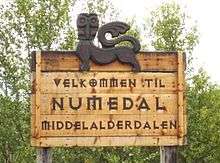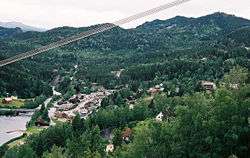Numedal
| Numedal | |
|---|---|
| District | |
|
Rødberg, the largest settlement in Numedal. | |
| Country | Norway |
| County | Buskerud |
| Region | Austlandet |
| Adm. Center | Rødberg[lower-alpha 1] |
| Area | |
| • Total | 3,513 km2 (1,356 sq mi) |
| Population (2014) | |
| • Total | 6,609 |
| • Density | 1.9/km2 (4.9/sq mi) |
| Demonym(s) | Numedøl |
Numedal is a valley and a traditional district in Eastern Norway located within the county of Buskerud. It traditionally includes the municipalities Flesberg, Nore og Uvdal and Rollag. Administratively, it now also includes Kongsberg.[1][2]
Numedal is the southernmost valley of the major valleys in Eastern Norway. Numedal is a largely a U-shaped valley. Most of the area is mountainous, especially west of the main valley, with steep valley sides. Running north–south, it extends between Flesberg in the south to Rødberg in the north, passing through the municipalities of Flesberg, Rollag and Nore og Uvdal. The Numedalslågen, the third-longest river in Norway, flows through the valley before discharging into Oslofjord at Larvik. National Road 40 runs from Larvik. National Road 7 crosses Hardangervidda to Geilo. Numedal Line Railway (Numedalsbanen) was opened in 1927 and stopped operations in 1988. The former railroad track from Veggli to Rødberg is now used principally for cycling. Agriculture and forestry are important industries in the valley along with hydropower generation, as well as growing tourist traffic.[3][4][5]
Etymology
The name comes from Nauma, the Old Norse name for the Numedalslågen, and dal meaning "valley". The origin and meaning of the name are the same as that of Namdalen.[1][6]
Attractions


Numedal is also the location of one of the "Norwegian paths" (Nordmannsslepene), which were the main roads between east and west. On the marked paths, remains of Stone Age dwelling places, bog iron works and grave mounds can be seen.[7][8]
The area along the Numedalslågen from Flesberg up to the Hardangervidda through the valley has a large number of examples of Medieval Scandinavian architecture. There are still over 40 historic timber buildings and four stave churches: Flesberg stave church, Rollag Stave Church, Nore Stave Church and Uvdal Stave Church.[9][10]
Numedal also has several museums including Nore og Uvdal Open Air Museum (Nore og Uvdal Bygdetun) in Uvdal, Rollag Open Air Museum (Rollag Bygdetun) in Rollag, and Dåset Open Air Museum (Dåset bygdetun) at Flesberg. These are collections of historic buildings, mostly built in the traditional style common for the valley.[11][12][13]
References
Notes
Citations
- 1 2 3 Thorsnæs, Geir. "Numedal". snl.no.
- ↑ "Numedal". norskfolkemuseum.no.
- ↑ "Key facts about Numedal". visitnorway.com.
- ↑ Heggstad, Ragnar. "Numedalslågen". snl.no.
- ↑ Holøs, Bjørn. "Numedalsbanen". snl.no.
- ↑ Heggstad, Ragnar. "Namsen". snl.no.
- ↑ Førde, Reidun. "Nordmannsslepene". snl.no.
- ↑ "Nordmannsslepene". historieboka.no.
- ↑ "Attractions in Numedal". visitnorway.com.
- ↑ "Stave churches". visitnorway.com.
- ↑ "Nore og Uvdal Bygdetun". visitnorway.com.
- ↑ "Rollag bygdetun". visitmiddelalderdalen.no.
- ↑ "Dåset bygdetun". visitmiddelalderdalen.no.
Literature
- Erla Bergendahl, Hohler (1999). Norwegian Stave Church Sculptur. Oslo: Scandinavian University Press. ISBN 978-82-00-12748-2.
External links
- Tour suggestions from Numedal
- Nordmannsslepene
- Nore og Uvdal Bygdetun
- Rollag bygdetun
- Middelalderuka i Numedal
Coordinates: 60°00′N 9°12′E / 60°N 9.2°E
